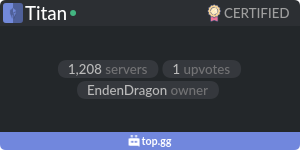Visit our website! https://titanembeds.com/ And get started right away!
https://docs.titanembeds.com/Self-hosting/ https://titanembeds.com/
There was a time when Discord doesn't support embedding the chat on a webpage. But with Titan, you can! It is as simple as 1, 2, 3!
- Invite the bot to your server (You must have "Manage Server" permissions)
- Configure the embed to your liking (toggling guest users, etc)
- Copy the iframe code and paste the line in your webpage!
- Guest users (a quick way to invite users who do not have a Discord account)
- Moderation Features (Kick & ban users by IP addresses, toggling guest users)
- Discord OAuth support. (Allows those who have a discord account to access the embed)
- Responsive material design! (Thanks materializecss!!)
- in your discord server go to the drop-down menu
- select "server settings"
- select "widget"
- enable the widget
- copy the server id if you have not already
- the widget is now available at https://discord.com/api/guilds//widget.json
Would you like to run your own copy of Titan Embeds? There are two parts that integrate nicely together. The webapp (website) handles the frontend and communication with the database to retrieve server messages, etc. The discordbot (bot) handles the communcation between Discord's websockets and pushing out the data to the database for the webapp. Check out the respective folder for their installation instructions. Titan is written in Python and requires Python 3.6.8 at minimum to run.
Once you cloned the project, install the Python depends with pip install -r requirements.txt.
Ensure that you are utilizing Python 3.6's pip.
If you happen to have a copy of Ubuntu on your server, you may head onto our Ansible Playbooks repository and perform a near-to-automatic installation of TitanEmbeds.
To set up the database for it to work with the webapp and the discordbot, one must use alembic to migrate their databases to the current database state. To do so, please follow these instructions. PostgreSQL supports proper indexing and suitable for Titan needs. For this reason, Titan only supports using a PostgreSQL database.
- Install alembic with Python 3.6's pip
pip install alembic - Change your directory to the webapp where the alembic files are located
cd webapp - Clone
alembic.example.iniinto your ownalembic.inifile to find and edit the following linesqlalchemy.urlto equal your database uri. See here if you need help understanding how database uri works in SQLalchemy. - In your terminal, run
alembic upgrade headto upgrade your database tables to the current version on git. As long as there are only INFO messages and no errors, you should be fine. - Check your database tables to see if they are created. If so, you have finished migrating your
database! Remember to run Step 4 every now and then just in case if there are database
updates. (Presumably on every
git pull).
Titan also requires a Redis instance in order to function. There is no specific prerequisites before utilizing Titan with redis. Follow the official Redis installation instructions to install and start redis.
The data flow is confusing.
The bot subscribes to the discord-api-req channel.
When the webapp gets values prefixed with Queue from redis it also publishes
details of the request to the discord-api-req channel.
The webapp uses this channel as an ad-hoc query interface to the bot:
First it runs get on the desired key - e.g. Queue/guilds/{guild_id}/members
If there is no value for that key it will publish a message of the format:
{
"key": `Queue/<key>`,
"resource": <resource>,
"params": <params>
}e.g.
{
"key": 'Queue/guilds/{guild_id}/members',
"resource": "list_guild_members",
"params": {"guild_id": <guild_id>}
}It then loops up to 50 times, sleeping for 0.1 second on each loop, and runs get
Queue/guilds/{guild_id}/members until it gets a response. If it does not find a
response it returns None.
The discordbot is subscribed to this channel and when it receives the message it
runs async, using the event loop's create_task() a method that matches the
resource field, passing the key and the params data.
e.g. for the data above it would run discordbot.redisqueue.RedisQueue.on_list_guild_members(), passing
key='Queue/guilds/{guild_id}/members', params= {"guild_id": <guild_id>}
The method then runs a query using the discord bot's query methods, and then
sets the supplied redis key to the result.
As long as this completes in the time it takes the webapp to run 50 get's (5s) it
kind of works.
Obviously this is a little disfunctional and the best approach would probably be to add a web interface to the bot that provided the same functionality.
Come and talk with us at our very own Discord server! We offer support too!
Visit us over at our CrowdIn project and teach Titan how to speak your language!
This project is never to be used as a replacement for Discord app. It is used in conjunction for a quick and dirty Discord embed for websites. Some uses are via shoutboxes, etc.

